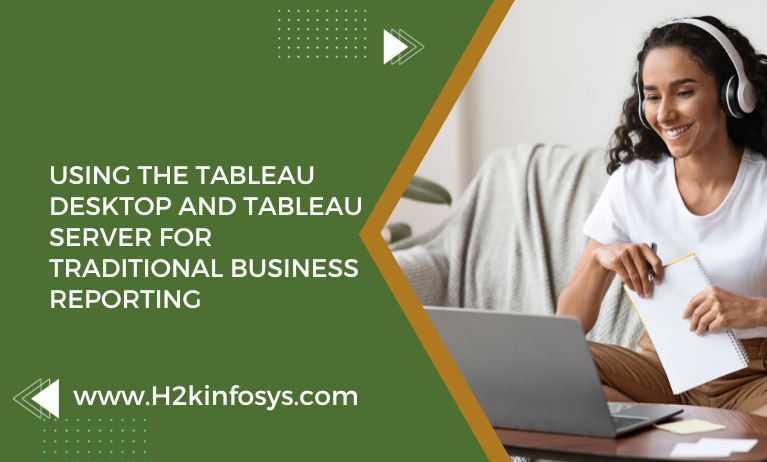Nowadays, we can share almost anything. We provide pictures of the food we eat, the places we visit, and our opinions on practically anything. On our phones, Tableau Desktop we can share with a growing number of social media and direct messaging networks with a single swipe and thumb click.
In this article, we’ll look at scenarios from the first two types of data sharing and how Tableau might be used to distribute the finished result. Check our Tableau online course to learn more.
Level 1: Traditional Business Reporting Using Tableau Desktop
As Tableau users, we are frequently requested to develop a visualisation to support a story, theory, or project that a coworker or manager is working on. Tableau Desktop was created to provide stunning graphics, after all.
Requests will flood the development queue after stakeholders inside an organisation have experienced firsthand the impact that a Tableau viz can have. These builds typically have arbitrary deadlines. Using data visualisation for enhancement is the primary driving force behind this.
Here is an example. Adventure Works sells bicycles and riding gear at branded locations in six different countries. The new CFO wants to see our monthly growth trends over the past three years because we have been growing generally during that time. The Finance department has often aggregated the data using pivot tables from an integrated SQL data connection within Excel.
The CFO is preparing a PowerPoint presentation for investors and would want to compare the sales in each nation to the global total along with the compound annual growth rate for the most recent month. They need a visualisation with a flat file that Finance has provided by the next day.
Complexity is not required in this case. The target is to develop a visualisation that would be displayed on one slide, followed by another, with a small audience and clear needs.
Benefits of Tableau Desktop
- Usually, data sources and links have already been created.
- Prerequisites for targeted data aggregation
- Needs for simplified designs
- Tableau Desktop is all that is needed to implement the few requests for stakeholder feedback.
Challenges with Tableau Desktop
- Make, utilise, and discard
- Delivery to a single stakeholder
- possibly requiring further information
- time-sensitive deadlines
- a workaround for a specific business need
Level 2: Internal Accessibility by Distributing on Tableau Server
A significant portion of a Tableau Developer’s time is devoted to developing more sustainable products through engineering, design, and research. Usually, this entails designing dashboards or reports with user functionality in mind, which implies that the person interacting with the views is learning new insights.
With specific insights or KPIs that are motivated by managerial aims, the granularity of the data aggregation is created at the user level. The outcomes of which could be used for recurring market updates or reporting. A Tableau Data Extract must be published to a Tableau Server environment in order to realise such a situation.
Refresh extracts that are scheduled on the server must be used to update the data often, and dashboards must be created, published, and sent to Tableau Viewers. At this stage, employing data visualisation for Exploration is the key driving force.
Let’s go back to our bicycle retailer, Adventure Works. Three revenue analysts on our team are responsible for identifying prospective demand trends from prior years based on seasonality by country and product. Every three weeks, each analyst is required to provide a managerial update that covers the progress of their respective regions, the highest-grossing goods, total sales, and comparisons to product and regional budgeting goals.
In a Tableau Extract that was uploaded to a Tableau Online Server environment, our sales fact has already been connected to product and category dimensions. The analyst team can go down into an interactive dashboard with linked visuals to acquire a fresh understanding of their particular markets.
The Tableau Server environment offers possibilities for interacting with views other than those that have been designed into the dashboard once a dashboard has been published. Users can be alerted by data-driven Alerts if scheduled data extract refreshes are outside of a predefined range. Emails and PDFs can be sent out on scheduled subscriptions.
Team members can also add Comments to views and dashboards that are sent to the content owner. Additionally, views can be shared directly on the server with authorised people or groups or through a copied link.
Benefits of Tableau Server
- Data sources are established, and stakeholders can provide input through the server environment.
- The granularity is determined by managerial KPIs.
- User engagement is tracked via server metrics data.
- The Tableau Server environment offers improved collaboration opportunities.
Problems with the Tableau Server
- Restricted audience and scope
- Tableau Server infrastructure and development are necessary for implementation, and continuous monitoring and iterative improvement are required. Design creep can reduce overall efficacy.
- Requirements for various types of user engagement for bigger teams
Conclusion You can check out the online Tableau training to learn more about Data sharing with Tableau.





























